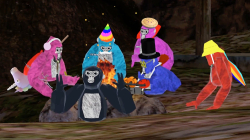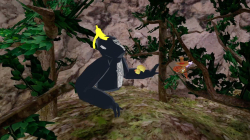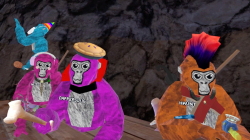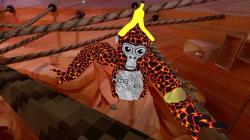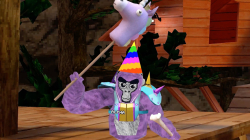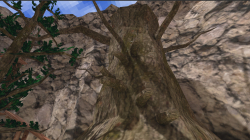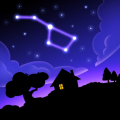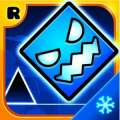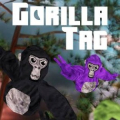
Gorilla Tag
All trademarks belong to their respective owners.Details
Stepping into a Lively Primate World
I recently dove headfirst into the world of Gorilla Tag, an experience that completely redefined my understanding of virtual playgrounds. As someone who cherishes immersive and physically engaging experiences, this game immediately drew me in with its unconventional approach to movement and interaction. In a realm where I could become a nimble primate navigating intricate environments, I felt an exhilarating sense of freedom that only a true VR experience can offer.
The Joy of Playful Locomotion
Every moment in Gorilla Tag is centered around movement. The game’s core mechanic—using natural arm swings to propel yourself through space—transformed my entire perspective on locomotion in virtual reality. I discovered that every motion carried weight and significance. The delicate balance between momentum and precision created a subtle learning curve that kept me fully engaged. Every leap and every grasp became a memorable act of skill and intention, inviting me to experiment with creative methods of traversal. It reminded me that sometimes the simplest actions can be the most invigorating experience of all.
The Thrill of High-Stakes Tagging
In the midst of a bustling digital jungle, I found myself fully immersed in the thrill of the chase. Gorilla Tag's multiplayer aspect encourages a playful competition reminiscent of childhood games. The adrenaline rush of chasing down other players combined with the ever-present humor and lighthearted competitiveness elevated the experience to an entirely new level. I wasn’t just playing a game; I was part of an ever-changing, dynamic social experiment where every round added layers of spontaneity and laughter.
Embracing the Unconventional Control Scheme
One of the aspects that truly captivated me was the unconventional control scheme. Rather than relying on traditional button presses or joystick movements, Gorilla Tag demands that you physically engage with your own body. By swinging your arms and physically emulating the actions of a gorilla, I was not only playing a game—I was partaking in an interactive workout that blurred the boundaries between gaming and exercise. This unique integration allowed me to feel more active and intensely connected to the environment around me. Every gesture felt crucial in navigating the digital forest, and that connection between your physical self and the virtual avatar is something that lingers in memory long after the session ends.
Engaging Multiplayer Dynamics and Unexpected Friendships
The multiplayer component of Gorilla Tag is where the game transforms into a vibrant social hub. As I swung from one branch to another in a seemingly endless digital parkour adventure, I found that each session introduced me to new friends and even some friendly rivals from across the globe. The camaraderie and spontaneous teamwork I experienced during group sessions contributed immensely to the game’s charm. Whether collaborating to create intricate obstacle courses or teasing each other over near misses, every interaction was imbued with a sense of community that transcended mere gameplay.
Customizing My Own Primate Persona
Another striking element of Gorilla Tag was the extent to which it encourages personalization. I was able to tweak various settings to refine my experience, from adjusting the game’s physics parameters to creating custom challenges. The freedom to craft my unique digital identity as a nimble primate offered a refreshing break from the monotony of predetermined character styles. I found that even subtle changes in the appearance and movement patterns could transform how I approached the game, adding layers of strategy and self-expression that continuously enhanced my overall enjoyment.
A Visual Journey Through Energetic Landscapes
The aesthetics of Gorilla Tag deserve a special mention. The environment blends vibrant hues with a raw, unpolished charm that strikes a perfect balance between simplicity and immersive design. The forested arenas and sunlit clearings are rendered in a way that inspires a feeling of both nostalgia and renewal. For me, this visual ambiance invited deep exploration and a sense of wonder with every new level. Even when the environment felt minimalistic, there was a distinct artistic vision at play—one that captured the untamed spirit of nature while ensuring the gameplay remained agile and responsive.
The Resonance of Sound in a Digital Wilderness
The audio landscape of Gorilla Tag played an integral role throughout my sessions. The interplay of subtle ambient tones with the crisp sounds of my avatar's movements created a harmonious audio experience that intensified my sense of presence. Every echo of a distant call, every rustle in the virtual undergrowth, resonated uniquely with the overall vibe of exploration. The sound design wasn’t just an afterthought; it was like an additional layer of reality, reinforcing the fantastical nature of the space while also grounding me in every leap and landing. Over time, I found that the audio cues helped me gauge my movements better, adding an intuitive overlay to the physicality of the game.
The Responsive World of Physics and Interactivity
What truly sets Gorilla Tag apart is its dedication to simulating a responsive and interactive world. The physics engine is finely tuned to reflect a realistic stance of momentum, gravity, and collision dynamics. While the game might seem whimsical at first glance, every movement felt weighted and deliberate. I was constantly aware of the room I played within, and the physical interactions, ranging from the firmness of branches to the bounce upon landing, provided a level of authenticity that deepened my immersion. Every swing became a calculated decision, shedding light on just how intricate a system as playful as this can be when backed by robust physics.
Fostering Creativity Beyond Standard Boundaries
As I traversed the varied landscapes of Gorilla Tag, I began to explore areas of creativity that many VR games might inadvertently overlook. The potential to create impromptu challenges, develop new routes, and even innovate ways to engage with other players transformed each session into a unique exploration of possibilities. I found myself not merely following a guide or looped map, but instead, I was part of an evolving landscape where ideas and innovation played out in real-time. Whether it was formulating new techniques to navigate obstacles or simply inventing games within a game, every moment sparked creativity beyond what I had expected in a typical VR shooter or puzzle experience.
Balancing Exercise with Entertainment
In my journey through Gorilla Tag, the game seamlessly merged the realms of physical exercise and pure entertainment. I relished the simultaneous challenge of staying active while navigating obstacles and interacting with fellow players. It was as if the game had been meticulously designed to harness the dual nature of VR—providing both a fun escape and an effective workout session. I experienced an energy boost not just from the physical effort involved, but also from the mental stimulation that came with planning each move and reaction. This balance meant that every session left me feeling accomplished in more ways than one, making my time invested both productive and enjoyable.
An Ever-Evolving Digital Playground
What truly excites me about Gorilla Tag is its inherent flexibility and capacity for evolution. The developers have crafted a world that is continuously enriched by community engagement, user feedback, and periodic updates. I became a part of a collective where new challenges, environments, and game modes often emerged out of a shared passion for exploration and fun. The anticipation of what might change next kept the game perpetually fresh in my eyes. Every update felt like an invitation to rediscover the digital playground anew, with each iteration reflecting a blend of creativity and technical ingenuity that kept me coming back repeatedly.
Understanding the Importance of Immersive Gameplay Mechanics
The more I delved into Gorilla Tag, the more I appreciated the thoughtful consideration given to every element of its design. The game’s immersive gameplay mechanics are not simply about aesthetics or physicality; they work in perfect harmony to create a unified experience. Whether I was exploring hidden crevices in a virtual forest or engaging in spirited chases with fellow primates, each moment was meticulously designed to evoke a sense of authenticity and immediacy. This attention to detail ensured that the game was never static, pushing me to continuously adapt and improve my techniques while cherishing the unpredictability of every session.
A Platform for Unspoken Adventures
Gorilla Tag has become more than just a game for me; it has evolved into a platform where untold adventures blossom at every turn. I found that every session brought with it the potential for serendipitous discoveries—whether that was a hidden pathway leading to a rarely explored corner of the map or an unexpected encounter with a fellow player that sparked a spontaneous mini-game. This organic discovery process kept my enthusiasm alive and ensured that the experience was always novel. It was refreshing to see a game that prioritized exploration and serendipity over a rigidly controlled narrative, allowing me to shape my own journey within its vibrant spaces.
Connecting with a Community Beyond the Game
One of the aspects that resonated with me most was the opportunity to connect with a diverse community. Through Gorilla Tag, I participated in events, group challenges, and spontaneous gatherings that went well beyond typical gameplay. The shared joy of exploring, competing, and collaborating with people from various backgrounds instilled a feeling of belonging, making each session a culturally rich experience. It was astonishing to see how a shared love for digital exploration could bridge gaps and foster genuine connections. Every interaction, whether competitive or cooperative, enriched my personal narrative within the game's sprawling digital ecosystem.
Adapting to New Challenges in a Fluid Environment
Another dimension of Gorilla Tag that particularly fascinated me was its fluid approach to challenges. Unlike many traditional VR experiences where environments and objectives are set in stone, this game thrives on spontaneity. The unpredictable nature of its multiplayer mode meant that every session was infused with an element of surprise, compelling me to constantly adapt. This dynamic environment kept my mind active and ensured that the game never felt monotonous. Instead, I found that every moment was an opportunity to test new strategies and discover alternative paths to overcome obstacles. This continual push and pull between anticipation and reaction made each challenge uniquely engaging.
Experiencing a Fusion of Play, Movement, and Connection
In the final analysis, Gorilla Tag has managed to encapsulate a rare blend of physical activity, imaginative design, and heartfelt community spirit. I experienced a fascinating interplay between the demands of physical movement and the ephemeral nature of digital interaction. The responsiveness of the environment, coupled with the playful unpredictability of the game's design, allowed me to view every session as a fusion of movement and connection. It is rare to find a game where every element—from the subtle shifts in physics to the spontaneous social dynamics—works in harmony to deliver a singular, unique experience. For me, every dive, every swing, every playful chase has contributed to a deeply personal journey through an endlessly evolving digital wilderness.
